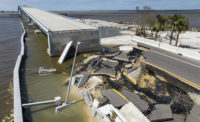Nashville and Middle Tennessee businesses and individuals are cleaning up and trying to return to thousands of buildings and homes inundated by floodwaters in a “once-in-one-thousand-year event.”

With one of the city’s two water plants still underwater, Nashville and neighboring Williamson County are under a mandatory water conservation order.
Power is out, at least until Friday, for a chunk of downtown after floodwaters knocked out underground transformers at a substation.
The Cumberland River, which runs through Nashville, crested at 51.9 ft late Monday after 13.5 in of rain fell on Saturday and Sunday. It had receded to 48.3 ft Wednesday morning and is expected to return to non-danger levels late Thursday. Flood stage is 40 ft.
Estimates on damages range from millions of dollars to billions, but those are only early estimates.
Davidson, Williamson, Cheatham and Hickman have been declared federal disaster areas. Gov. Phil Bredesen is seeking aid for another 48 counties. City teams had started damage assessments Tuesday, covering about 10% of the area.
State and federal teams won’t even start their assessments until Monday.
“They won’t know until the water is gone,” says Bill Young, executive vice president of the Associated General Contractors of Tennessee. “It’s going to be in the millions … and could be billions.”
The most famous building under water is the Grand Ole Opry House, in the Gaylord Entertainment Co. complex northeast of downtown in a bend in the Cumberland River.
Floodwater reached the Opry stage, forcing relocation to the Ryman Auditorium, its former home.
The 2,881-room Gaylord Opryland Resort is closed indefinitely with 10 ft of water in restaurants and public areas. Some 2,000 guests and employees were evacuated Sunday night when floodwaters started rising.
Opry Mills, a shopping mall built on the old Opryland USA theme park site, also was flooded, its parking lots and access roads under water.
Downtown, the Bridgestone Arena, home to the Nashville Predators, had a foot of water on the main level and the Schermerhorn Symphony Center suffered water in its basement but not the main concert hall.
The Pinnacle, a 29-story office tower completed last year, had about 40 ft of water in the basement and underground parking garage.
“We hope to start pumping water out” on Wednesday, says Kevin Hagan, director of property management for Nashville Commercial Real Estate Services.
It could take two to three days before they can start evaluating systems, but they are re-ordering electrical panels, some HVAC circuits and parking equipment, he says.
Five state office buildings downtown remained closed Wednesday, as well as those in MetroCenter, an office park north of town created 40 years ago in a former landfill. It was evacuated after a levee was in danger and sandbagging started.
Local jail inmates shoveled 225,000 tons of sand for sandbags to protect the Omohundro Water Plant near downtown, which was less than 1 ft from flooding.
The Army Corps of Engineers monitored water levels in Nashville and downstream in Clarksville, where the river crested at 62.6 ft, well above its 46-ft flood stage. It had receded to 60.6 ft Wednesday.
Two upstream dams, the Wolf Creek in Kentucky and Center Hill in Tennessee, are undergoing repairs because of seepage, so those lake levels had to be monitored for pressure on the structures, says spokeswoman Allison Jarrett.
Interstate highways were open by Tuesday but state highways were closed in 50 locations, half of them still under water, says Paul Degges, chief engineer for the Tennessee Department of Transportation.
“We are doing assessments now, and we are doing what repairs we can with in-house crews,” he says. One section of U.S. 70 near Pegram, Tenn., was covered by a rain-related landslide.
TDOT was opening bids Wednesday for on-call emergency repairs. Like the Gulf Coast after Hurricane Katrina, the damage means rebuilding and repair work.
“I’ve already had two people from out of state call and ask how to get a contractor’s license in Tennessee,” the AGC’s Young says.






